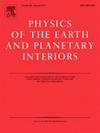Rutile's pressure-temperature-time evolution dictates its role as a depth-dependent subduction-zone water regulator
IF 1.9
3区 地球科学
Q2 GEOCHEMISTRY & GEOPHYSICS
引用次数: 0
Abstract
The deep Earth water cycling is critically regulated by hydrogen storage capabilities of nominally anhydrous minerals (NAMs). Rutile TiO2, a prevalent NAM in subduction zones, incorporates measurable hydrogen via defect-mediated mechanisms. However, its molecular-level structural evolution and hydrogen content variations under subduction-relevant conditions remain poorly constrained. This study integrates spatially resolved Raman imaging and Fourier transform infrared spectroscopy to quantitatively elucidate the microstructural and hydrogen dynamics in rutile across various pressure-temperature-time (P-T-t) trajectories. The results reveal that during prolonged cold subduction (geothermal gradient of ∼5 °C/km), pressure enhances microstructural ordering and crystallinity in rutile, leading to hydrogen loss. Conversely, thermal activation generates microstructural defects, which serves as additional sites for hydrogen incorporation. Quantitative hydrogen tracking demonstrates that rutile undergoes ∼50 % dehydration in anhydrous environments, which is inhibited by the rutile-to-akaogiite transformation. This transformation initiates at ∼8 GPa due to molecular heterogeneity, yet the kinetic stability provided by polar covalent Ti![]() O bonds enables rutile to persist up to ∼20 GPa. Notably, rutile exhibits ∼12 % hydrogen uptake upon prolonged fluid infiltration along cold-to-hot subduction pathways (geothermal gradients of ∼5–20 °C/km). In the continuous aqueous environments typical of subduction zones, these findings establish rutile as a depth-dependent water regulator. It can transport water beyond its initial content to mantle depths exceeding ∼300 km, thus advancing our understanding of how NAMs modulate water cycling in subduction zones.
O bonds enables rutile to persist up to ∼20 GPa. Notably, rutile exhibits ∼12 % hydrogen uptake upon prolonged fluid infiltration along cold-to-hot subduction pathways (geothermal gradients of ∼5–20 °C/km). In the continuous aqueous environments typical of subduction zones, these findings establish rutile as a depth-dependent water regulator. It can transport water beyond its initial content to mantle depths exceeding ∼300 km, thus advancing our understanding of how NAMs modulate water cycling in subduction zones.

金红石的压力-温度-时间演化决定了其作为深度依赖的俯冲带水调节器的作用
地球深部水循环受到名义上无水矿物(NAMs)储氢能力的关键调控。金红石TiO2是一种普遍存在于俯冲带的不饱和金属,通过缺陷介导的机制结合了可测量的氢。然而,在俯冲相关条件下,其分子水平的结构演化和氢含量的变化仍然缺乏研究。该研究整合了空间分辨拉曼成像和傅里叶变换红外光谱,定量地阐明了金红石在不同压力-温度-时间(P-T-t)轨迹中的微观结构和氢动力学。结果表明,在长时间的冷俯冲过程中(地温梯度为~ 5°C/km),压力增强了金红石的微观结构有序性和结晶度,导致氢的损失。相反,热活化会产生微观结构缺陷,这是氢结合的额外场所。定量氢跟踪表明,金红石在无水环境中脱水~ 50%,这一过程被金红石向阿高岭石的转化所抑制。由于分子异质性,这种转变始于~ 8 GPa,但极性共价TiO键提供的动力学稳定性使金红石能够持续到~ 20 GPa。值得注意的是,金红石在沿冷-热俯冲路径(地热梯度为~ 5-20°C/km)的长时间流体渗透过程中表现出~ 12%的氢吸收率。在俯冲带典型的连续水环境中,这些发现证实金红石是一种依赖于深度的水调节剂。它可以将超过其初始含量的水输送到超过~ 300公里的地幔深度,从而促进了我们对NAMs如何调节俯冲带水循环的理解。
本文章由计算机程序翻译,如有差异,请以英文原文为准。
求助全文
约1分钟内获得全文
求助全文
来源期刊

Physics of the Earth and Planetary Interiors
地学天文-地球化学与地球物理
CiteScore
5.00
自引率
4.30%
发文量
78
审稿时长
18.5 weeks
期刊介绍:
Launched in 1968 to fill the need for an international journal in the field of planetary physics, geodesy and geophysics, Physics of the Earth and Planetary Interiors has now grown to become important reading matter for all geophysicists. It is the only journal to be entirely devoted to the physical and chemical processes of planetary interiors.
Original research papers, review articles, short communications and book reviews are all published on a regular basis; and from time to time special issues of the journal are devoted to the publication of the proceedings of symposia and congresses which the editors feel will be of particular interest to the reader.
 求助内容:
求助内容: 应助结果提醒方式:
应助结果提醒方式:


